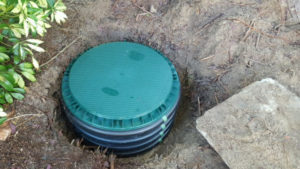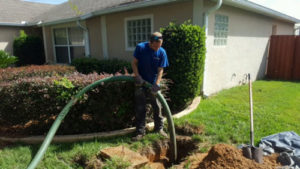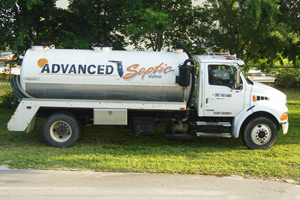Pump outs and septic pumping are important services provided by Advanced Septic Services of Clermont, FL. These services are an important part of septic system maintenance and problem prevention. Not only do pump outs remove the waste your system was unable to process, they help identify problems before they become significant and costly repairs.
How Often Should You Pump Out A Septic Tank?
It is recommended that you have your septic tank system pumped out every three to five years. A septic system requires the pump out service because of solids which accumulate and begin to fill up the tank. The tank should be pumped when the solid wast line reaches 30% – 50% capacity.
The use of different chemicals and enzymes is common to help with septic tank maintenance. These septic system chemicals and enzymes activate digestion in the systems to unclog the drainfields. Using these materials can help prolong the life of your septic tank system. In addition, the price of the chemicals and enzymes compared to the price of a septic tank system repair is quite low.
Why Do I Need Septic Tank Pumping?
The septic tank is an essential part of your septic system. Buried under the ground, your septic tank holds all the solid waste and wastewater flushed from your household or building.
Once in the tank, grease and oils float along the top while solids sink to the bottom of the tank. Eventually, these sunken solids form a sludge layer that is impassable from your septic tank.
So, how do you get rid of the sludge layer? Well, natural bacteria helps break down some of the waste but the rest will need removed by your local septic professional, with a septic pumping or pump-out.
What Happens During Septic Pump Outs?
During septic pump outs, the main objective is removing built-up solid waste from your tank, allowing your septic system to process future waste efficiently and effectively. But, what steps do we take?
Step 1 – Finding the Tank
Sometimes, this is the most challenging step of the septic pumping process. Frequently, owners may not know the exact location of their septic system and septic tank. This means a fun game of hide-and-go find the tank.
Step 2 – Digging To Uncover The Tank Lid
 Once we’ve located the tank, we must remove the grass, dirt, and lawn covering the lid entry to the septic tank. Depending on the system this could be one or two entry points.
Once we’ve located the tank, we must remove the grass, dirt, and lawn covering the lid entry to the septic tank. Depending on the system this could be one or two entry points.
At Advanced Septic Services, we take great care to preserve your lawn and surrounding landscaping during the pumping service. We carefully remove any grass turf in chunks so it can be easily placed back.
Also, a tarp is laid on the ground to protect the lawn and hold the dirt that is dug out to reach the tank cover. Once the septic tank has been pumped the soil is used to fill the hole, and the sod is placed on top. You will barely notice a disturbance.
You also have the option of installing septic risers and covers for convenient access without future digging.
Step 3 – Running the Hoses
At this point, we will run the hoses from our truck into your tank.

Step 4 – Pumping the Septic Tank
Say goodbye to all the untreated waste from your tank and say hello to a fresh system.
Also, if your system includes an effluent filter we will remove it, clean it and return it to its proper place.
Step 5 – Closing the Tank & Replacing the Dirt and Grass
At this point, the septic pump-out is complete.
Once all of the solid waste and grease have been removed, we will return the hoses to the truck, securely close your tank and replace any landscaping moved in the process.
Step 6 – Paperwork and System Status
At the end of each pump-out visit, we will touch base on the status of your system, any issues we may have found and any repair or maintenance suggestions.
We will also give you a copy of the invoice showing how much waste was removed and how much was charged for the service. Along with letting you know if your tank has a baffle and/or filter and if there were any additional notes about the health of your septic system.
On-Going Septic System Maintenance
Septic pump-outs are simple and easy and not often required — as long as you are following best practices for septic systems and treating your septic system with care.
How do you properly care for a system that lives underground? By treating it kindly and following a few simple rules.
- Follow Do Not Flush Rules. Your septic system and the septic tank isn’t a trashcan, and there are some things that you should never flush down the drain.
- Use Water Efficiently. Not only does this save you money and help the environment, but it also reduces the amount of pressure put on your system.
- Maintaining (and Avoiding) the Drainfield. Keep things including trees, shrubs, cars, and rainwater away from your drain field.
- Know When to Call the Professional. Having a trusted septic professional on hand for when you notice issues can go a long way from turning a hiccup into a costly repair.


